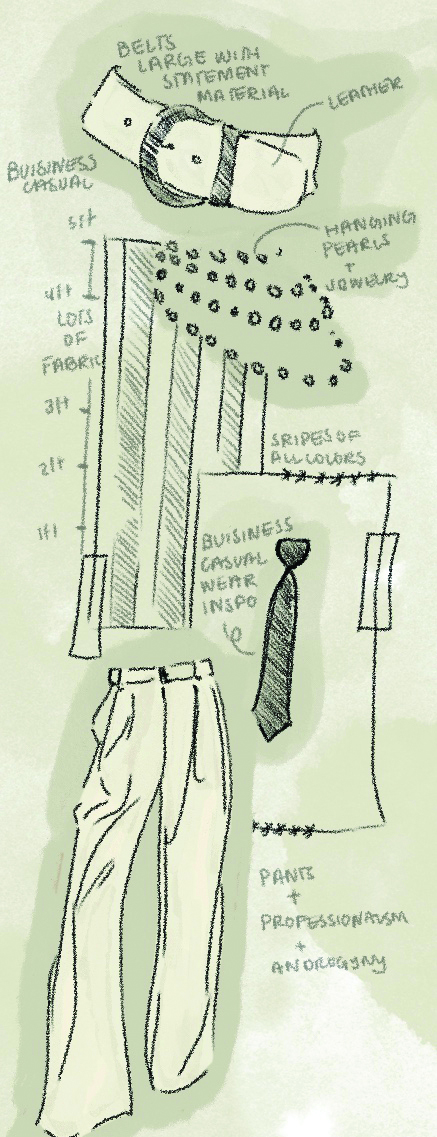The topic of fast fashion has become increasingly prevalent in national and international media discourse. Fast fashion is the adoption of clothing trends from designer runways that are mass produced cheaply and quickly. Trend replication, high-speed production and low quality materials are all employed by major multinational retail corporations like Nike or Zara to bring accessible and fashionable styles to consumers.
In recent years, companies have shifted increasingly towards supporting fast fashion practices. According to The Economist, global clothing production doubled between 2000 and 2014. In the past, clothing was produced seasonally with clothing brands creating distinct winter, spring, summer and fall lines. However, as garment firms’ operations became more efficient, their production cycles sped up, granting shoppers access to better bargains. Fast fashion brands such as Zara offer more than 20 new lines a year, while Forever 21 ship in new styles daily. Topshop introduces nearly 400 styles a week on its website. These brands are infamous for knocking off high-end designer trends, allowing customers to purchase styles at a fraction of their original prices.
Fast fashion appeals to consumers because it enables them to keep up with the newest trends. According to an UltraViolet survey of the Marlborough student body with 91 responses, 71% of respondents said that they prioritize style and look when buying new clothes, while only 3.4% of respondents prioritize workers’ wages or environmental impact. Correspondingly, 100% of survey respondents said they shop at least one of five listed fast fashion retailers, including Forever 21, Victoria’s Secret and Zara.
Madison Choi ’19 said people tend to prioritize style because of social pressures to keep up with new trends.
“I think human psychology has a lot to do with it because people definitely want to stay with the trends,” Choi said. “I think there’s a very social aspect to shopping, not just when you’re going shopping, but also dressing a certain way and fitting in is something that’s integral to a lot of social scenes.”
Rapid growth of the fast fashion industry is also caused by the emergence of online shopping. Many consumers have become accustomed to purchasing clothes, products and services over the Internet, in part due to the convenience of bargain shopping from the comfort of one’s own home. According to Forbes contributor Andrew Arnold, one of the most enticing factors about online shopping is the consumer’s ability to avoid long lines or search from store to store for a particular item.
Social media has also become a popular sales platform for many fast fashion brands. Arnold writes that approximately 40% of all business owners use social media to generate sales. 78% of respondents to the UltraViolet survey said social media contributes to their clothing purchases and sense of clothing trends.
In 2018, Instagram launched a shopping feature to make it easier to purchase items seen on the app. Users are able to click on image tags to see additional information about products, including any product descriptions and price information.
Ava Morgan ’20 said she thinks the convenience of shopping online or through social media drives an increase in purchases by creating separation between consumers and the physical process of cash transfer.
“It’s easier to spend money online since you just click a button—you’re not physically handing over cash the same way you do in stores—so it doesn’t seem to have the same sense of financial consequence,” Morgan said.
Avery Crystal ’20 agreed with Morgan. “It is easier to spend a lot of money when you are putting items in a virtual cart; you feel less limited by the price,” she said.
Effects
Clothes shopping has become a new form of entertainment separated from its utilitarian purpose as keeping up with the latest trends is easy and cheap. Consequently, customers’ addiction to rapid fashion cycles––in part motivated by social media––has proved disastrous for the environment and workers.
Consumers’ impulses to buy new clothes leads to the disposal of old clothes. In 2015, the Environmental Protection Agency (EPA) estimated that landfills received 10.5 million tons of municipal solid waste (MSW) textiles. This accounted for 7.6% of all MSW in landfills.
Most fabrics are made from natural fibers, such as cotton or linen, but they undergo unnatural processes during production that introduces chemicals. Practices like bleaching or dying prevent these fibers from easily breaking down in landfills and introduce the risk of chemical leakage into groundwater. Moreover, toxins are released into the air if clothes are incinerated. In 2012, over 80% of unwanted clothes in the United States ended up in a landfill or incinerator. A Newsweek article stated that the volume of disposed clothing has doubled from 7 million to 14 million tons in less than 20 years, amounting to about 80 pounds per person.
“If you want to do the most environmentally sustainable thing, you either buy clothes that are new and then keep them for a really long time,” Environmental Science Instructor and Science Department Head Jennifer Garrison-Ross said. “Or, even better, you buy used clothing or thrift shop stuff that has already been produced.”
Additionally, the cost of transportation emissions compounds environmental damage. Companies tend to outsource production jobs in countries with the cheapest wages and lenient environmental regulations. Often the best locations for these processes are spread across the globe. The main growers of cotton, for example, are China and India, but many garment factories are located in Bangladesh.
“The fashion industry does move goods around the planet a lot more than a lot of other industries, in part because the stuff is light, so it’s cheaper to ship around,” Garrison-Ross said.
Fast fashion takes its toll on workers, too. According to The New York Times, tens of millions of people in developing countries, including children, work long hours in dangerous conditions to make clothing for fast fashion brands in sweatshops. Today, a majority of the world’s 75 million garment workers, 80% of which are women, live in China and Bangladesh, the top-two clothing producers, where they often earn just a few dollars a day. According to Forbes, the fashion industry is the second most exploitative industry internationally.
An example of the devastation caused by the garment industry was on April 24, 2013 at Rana Plaza in Bangladesh, where over 1,100 people employed at garment
factories were killed in the collapse of the eight-story building due to cracks in the lower floors. Human rights activists responded by demanding improved conditions for workers from major clothing companies, including H&M and Gap.
Despite poor factory conditions, some claim that preserving fast fashion practices are important to make sure that lower-income families can afford clothing. Further, some businesses have slowly been making progress toward sustainability. As recently as Jan. 24, H&M expanded their partnership with the International Labour Organization to jointly promote improved working conditions in the textile and garment industry supply chains. There are steps that consumers can take as well to reduce their environmental footprint.
“I don’t know about fixing the stuff we’ve done, but we can stop doing the damage that we’re doing just by keeping things longer, and that goes from fashion to cell phones to mugs to everything,” Garrison-Ross said.
Backlash
As fast fashion grows, other movements have also been expanding in opposition to its controversial practices. Specifically, “sustainable fashion” focuses on the environmental impacts, while “ethical fashion” concerns impacts on the workers. “Slow fashion” aims to bring together both sustainable and ethical fashion through slow production and fashion cycles.
In fact, Unilever, a consumer goods company that owns more than 400 brands of various hygiene, food, and other products, cited that their sustainable brands grew 50% faster than their other brands and accounted for 60% of their overall growth in 2016.
Along with a growth in popularity of sustainable brands, there is more discussion of fast fashion online. Youtuber Kristen Leo, who recommends strategies for reducing the consumption of fast fashion, says the first step is to consider the “five Rs” (reflect, reduce, repair, reinvent and recycle).
The first of the five R’s, “reflect,” calls the buyer to rethink possible purchases to avoid buying unnecessary items.
The next R, “reduce,” stands for curating a smaller wardrobe that is less focused on fleeting trends, and more focused on long-lasting, quality pieces that will be worn often.
The documentary “The True Cost,” which covers the global impact of fast fashion, points out that one would have to wear one item of clothing at least 30 times to make up for the environmental impact of its production.
The next R, “repairing,” entails refurbishing damaged clothes, while also taking care of and respecting all clothes to prevent future damage. This includes upcycling a piece of clothing into a new style or completely transforming it to be a pillowcase, homemade garland, bag or blanket.
Finally, the last of the five R’s, “recycle,” encourages donating worn out or unwanted clothes to a thrift store or selling them to second hand shops.
Leo explains it is better to find a specific home for a piece of clothing rather than donating to thrift stores. This is because, based on the EPA estimates, on average only 10% of donations to thrift stores actually are sold at the store due to strict quality regulations, while the rest is sold to recycling companies or ends up in landfills.
The main ways to buy sustainable and ethical clothing is through second-hand realtors, which Leo prefers over buying new clothes from sustainable companies.
“When it comes to purchasing new items, in my personal opinion, second hand is the most environmentally friendly way because you’re not directly contributing to the production of new items,” Leo said in a video on how to quit fast fashion.
At Marlborough, 79.1% of respondents from the UltraViolet survey said they have shopped at a thrift or vintage store.
Alex Leeman ’19 said thrift shopping has made her more conscious of her style.
“I like thrift shopping because you can always find something unique and something that not a lot of other people own, not to mention that it’s also so much better for the environment than fast fashion,” Leeman said.
Although many believe buying second-hand clothing is more sustainable, others have criticized the ethics of some specific thrift stores and organizations. For instance, investigative journalist John Hrabe found that 70% of Goodwill’s locations pay some of their employees less than the federal minimum wage, with an hourly wage as low as 22 cents per hour, while some executives make millions.
“More than 100 Goodwill entities employ workers through the Special Wage Certificate program, a Depression-era loophole in federal labor law that allows organizations to pay subminimum wages to people with disabilities,” Hrabe writes. “These same Goodwill entities that use the special wage program simultaneously spent $53.7 million in total executive compensation.”
In addition to the possible ethical implications of thrift shopping, others have found using alternatives to fast fashion to be an inconvenience. Sophie Penn ’19 explained that although she understands the controversial practices within the fashion industry, she finds fast fashion difficult to avoid.
“While morally we know that fast fashion is unsustainable and unethical, we participate in it anyway. For me, I think the biggest inhibitor of quitting fast fashion is convenience. Also, being someone who doesn’t fit sizes that are found in most thrift stores, shopping at fast fashion stores is much easier because they have more than one of each item,” she said.
In addition to thrift stores, vintage shops and clothing swaps, it is also possible to purchase second-hand clothing online. Apps like Poshmark and Depop, used by 28% of UltraViolet survey respondents, allow people to sell their own clothing and buy pre-owned clothing. For some, using these apps is preferable to thrift shopping because users can sort the inventory by color, style or size.
There are also more expensive ethical options, including websites like RE/DONE that sell tailored, modernized vintage jeans, or Reformation, a fast fashion company that attempts to be sustainable.
Despite the rise in popularity of shops like Reformation (which just over 50% of the UltraViolet survey respondents have heard of) and RE/DONE, there has been criticism that the ethical and sustainable fashion movement is not inclusive for all budgets.
“I would love to only shop sustainably, but sustainable brands like Reformation are not very accessible to everyone. They’re expensive,” Leeman said.
Julia Eschenasy ’20 said she underwent a shift when she stopped buying unethical and unsustainable fashion and encourages members of the Marlborough community to do the same.
“For me it’s not that sustainable financially, but you have to remember that although the price may be jarring at first, the items will last longer and you’ll feel better wearing them. For this community though, most people can afford a lot of clothes and are buying clothing at essentially the same price, so why not support sustainable and ethical shops if you can?” she said.
These shifts are evident, as 45.1% of the survey respondents said that they personally want to quit fast fashion. Eschenasy added that although it is tricky to stop buying fast fashion completely, it is still possible to set achievable goals.
“It is really hard to quit fast fashion and completely distance yourself from exploitation… I think encouraging a reduction is more reasonable. Starting on a smaller scale and moving up will lead to more change,” she said.
















